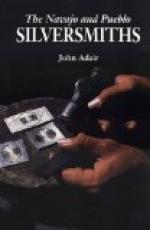These Indians are quite fertile in design. In Pl. XIX are shown two powder-chargers, which I consider very graceful in form. I have seen many of these powder-chargers, all very graceful, but no two alike except in cases where duplicates had been specially ordered. Their designs upon bracelets and rings are of great variety. Ornaments for bridles, consisting of broad bands of silver, sufficient in size and number to almost entirely conceal the leather, are not particularly handsome, but are greatly in demand among the Navajos and are extensively manufactured by them. Leather belts studded with large plates of silver are favorite articles of apparel, and often contain metal to the value of forty or fifty dollars. Pl. XX represents an Indian wearing such a belt, in which only three of the plates are shown. Single and double crosses of silver are represented attached to his necklace. The cross is much worn by the Navajos, among whom, I understand, it is not intended to represent the “Cross of Christ,” but is a symbol of the morning star. The lengthening of the lower limb, however, is probably copied from the usual form of the Christian emblem. These savage smiths also display much ingenuity in working from models and from drawings of objects entirely new to them.
They are very wasteful of material. They usually preserve the clippings and melt them in the crucible, or use them in soldering; but they make no attempt to save the metal carried off in filing, polishing, and by oxidizing in the forge, all of which is considerable. In one article of silver, for which, allowing for clippings saved, 836 grains were given to the smith, and the work on which I watched so closely throughout that I am certain none of the material was stolen, there was a loss of 120 grains, or over 14 per cent.
The smiths whom I have seen working had no dividers, square, measure, or any instrument of precision. As before stated, I have seen scissors used as compasses, but as a rule they find approximate centers with the eye, and cut all shapes and engrave all figures by the unaided guidance of this unreliable organ. Often they cut out their designs in paper first and from them mark off patterns on the metal. Even in the matter of cutting patterns they do not seem to know the simple device of doubling the paper in order to secure lateral uniformity.
Here ends my description of the smithcraft of a rude but docile and progressive people. I trust that it may serve not only to illustrate some aspects of their mental condition, their inventive and imitative talents, but possibly to shed some light on the condition and diffusion of the art of the metalist in the prehistoric days of our continent, notwithstanding the fact that some elements of their craft are of recent introduction and others of doubtful origin.
[Illustration: Pl. XX. Navajo Indian with silver ornaments.]




